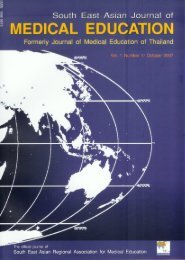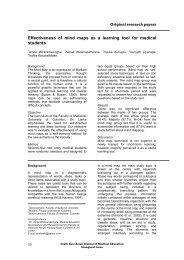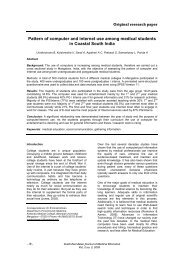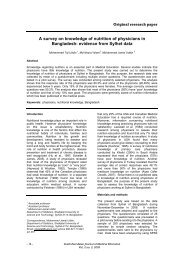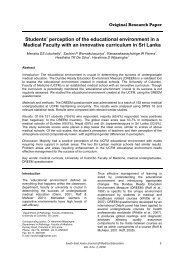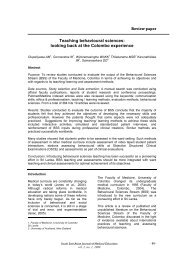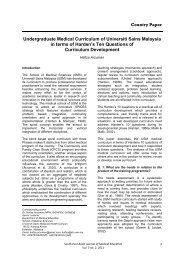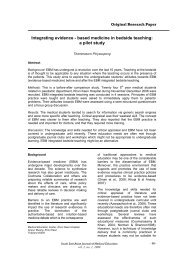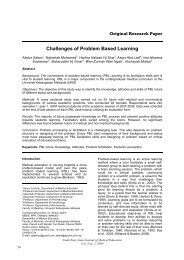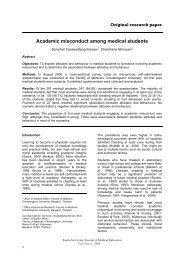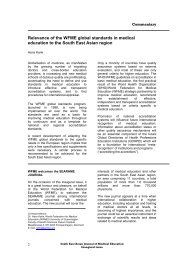Assessment of perception of first professional MBBS students in ...
Assessment of perception of first professional MBBS students in ...
Assessment of perception of first professional MBBS students in ...
You also want an ePaper? Increase the reach of your titles
YUMPU automatically turns print PDFs into web optimized ePapers that Google loves.
<strong>in</strong>clusion <strong>of</strong> an evaluation system or items<br />
at regular <strong>in</strong>tervals. Conspicuously, some<br />
respondents (11) have opted for more<br />
stress on applied and cl<strong>in</strong>ical aspects <strong>of</strong><br />
each topic. A similar report from the<br />
College <strong>of</strong> Medic<strong>in</strong>e <strong>of</strong> the University <strong>of</strong><br />
Arkansas, USA, outl<strong>in</strong>es changes <strong>in</strong> the<br />
<strong>students</strong>’ attendance from poor to high on<br />
<strong>in</strong>troduc<strong>in</strong>g changes to teach<strong>in</strong>g methods<br />
such as <strong>in</strong>troduc<strong>in</strong>g cl<strong>in</strong>ically oriented<br />
topics, <strong>in</strong>dependent learn<strong>in</strong>g etc (McMillan<br />
& Wenger, 1987). The f<strong>in</strong>d<strong>in</strong>gs <strong>of</strong> the<br />
present study suggest that it may be<br />
possible to enhance <strong>students</strong>’ <strong>perception</strong><br />
<strong>of</strong> the value <strong>of</strong> a teach<strong>in</strong>g session by<br />
modify<strong>in</strong>g the session <strong>in</strong> the light <strong>of</strong><br />
student’s based evaluation.<br />
Accord<strong>in</strong>g to the prevail<strong>in</strong>g system <strong>of</strong><br />
education <strong>in</strong> India, a transition occurs from<br />
<strong>in</strong>dividualized care <strong>in</strong> ‘10+2’ level to an<br />
<strong>in</strong>stitution-based care dur<strong>in</strong>g their medical<br />
education course. As a result, the <strong>students</strong><br />
face certa<strong>in</strong> difficulties to adapt to this new<br />
environment. This calls for a shift <strong>of</strong><br />
attitude on the part <strong>of</strong> the learners to get<br />
accustomed to this new mode teach<strong>in</strong>glearn<strong>in</strong>g.<br />
Hence, <strong>in</strong> the present study, the<br />
<strong>students</strong>’ feedback obta<strong>in</strong>ed should also<br />
be <strong>in</strong>terpreted <strong>in</strong> this context. Some <strong>of</strong> the<br />
items <strong>in</strong>cluded <strong>in</strong> the questionnaire were<br />
specifically designed to elicit responses to<br />
assess the extent <strong>of</strong> this adaptation. The<br />
observations <strong>of</strong> the study <strong>in</strong> particular, the<br />
f<strong>in</strong>d<strong>in</strong>g that 77% <strong>of</strong> the <strong>students</strong><br />
express<strong>in</strong>g their preference <strong>of</strong> each broad<br />
section to be taught by a s<strong>in</strong>gle teacher,<br />
their ‘suggestions for improvement’<br />
<strong>in</strong>clud<strong>in</strong>g the need <strong>of</strong> more <strong>in</strong>teractive<br />
sessions <strong>in</strong> small groups, <strong>in</strong>creased scope<br />
for clarification <strong>of</strong> doubts, extra tutorial<br />
classes, repetition <strong>of</strong> important concepts,<br />
discussion <strong>of</strong> model questions and<br />
answers and preference for frequent<br />
formative oral evaluation (items) <strong>of</strong><br />
<strong>in</strong>dividual <strong>students</strong> <strong>in</strong> presence <strong>of</strong> a s<strong>in</strong>gle<br />
facilitator - a junior or senior faculty<br />
member, reflected that the learners still<br />
prefer to be taught <strong>in</strong> a predom<strong>in</strong>antly<br />
<strong>in</strong>dividualized care-based environment.<br />
Surpris<strong>in</strong>gly, not a s<strong>in</strong>gle student<br />
mentioned Computer Assisted Learn<strong>in</strong>g<br />
(CAL) as a potential vehicle <strong>of</strong> teach<strong>in</strong>glearn<strong>in</strong>g.<br />
One reason for this could be<br />
ignorance regard<strong>in</strong>g the advantages <strong>of</strong><br />
CAL. In one study on the use <strong>of</strong> CAL<br />
(Bhavsar et al., 1994) it was po<strong>in</strong>ted out by<br />
the authors that a large number <strong>of</strong><br />
<strong>students</strong> expressed the advantages <strong>of</strong><br />
CAL and that if properly <strong>in</strong>troduced, CAL<br />
can go a long way <strong>in</strong> teach<strong>in</strong>g<br />
undergraduate medical <strong>students</strong> <strong>in</strong> future.<br />
The present study, however suffers from<br />
certa<strong>in</strong> drawbacks. The probability for<br />
objectivity would have <strong>in</strong>creased if the<br />
responses had been elicited on a five po<strong>in</strong>t<br />
scale for each question <strong>in</strong>stead <strong>of</strong> the<br />
given three. This would also have been<br />
more appropriate <strong>in</strong> evaluat<strong>in</strong>g the<br />
attitud<strong>in</strong>al parameter <strong>of</strong> the <strong>students</strong>.<br />
Further, the questionnaire had been<br />
designed encompass<strong>in</strong>g a limited aspect <strong>of</strong><br />
the teach<strong>in</strong>g learn<strong>in</strong>g process which was<br />
deemed by the authors to be sufficient for<br />
the objectives <strong>of</strong> the present study.<br />
Thus, it may be concluded from the<br />
present study that the feedback from the<br />
<strong>students</strong> had facilitated a change <strong>in</strong> the<br />
preconceived notions about teach<strong>in</strong>glearn<strong>in</strong>g<br />
pr<strong>in</strong>ciples on the part <strong>of</strong> the<br />
faculty. On the other hand, it should also<br />
be taken <strong>in</strong>to consideration <strong>of</strong> how far the<br />
<strong>in</strong>ability <strong>of</strong> the <strong>students</strong> to cope with the<br />
exist<strong>in</strong>g predom<strong>in</strong>antly <strong>in</strong>stitutionalized<br />
care-based medical education system may<br />
be attributed to a lack <strong>of</strong> or <strong>in</strong>complete<br />
attitud<strong>in</strong>al shift.<br />
References<br />
Ananthkrishnan, N. (2000) Microteach<strong>in</strong>g as a<br />
vehicle <strong>of</strong> teacher tra<strong>in</strong><strong>in</strong>g: An appraisal, In:<br />
Ananthkrishnan N., Sethuraman K.R., & Kumar<br />
S., (eds.) Medical Education: Pr<strong>in</strong>ciples and<br />
practice, 2 nd ed. Pondicherry: JIPMER, pp. 93-<br />
97.<br />
Bhavsar, V.H., Vajpayee, S.K., Joshi, N.J.,<br />
Mistry, S.D., Kantharia, N.D., Sharma, A.K., et<br />
al. (1993) Tra<strong>in</strong><strong>in</strong>g dur<strong>in</strong>g practical<br />
pharmacology sessions for undergraduate<br />
medical <strong>students</strong>: An experience with a<br />
modified teach<strong>in</strong>g programme, Indian Journal<br />
<strong>of</strong> Pharmacology, 31, pp. 176-186.<br />
d’Lvernois, J.F. (1991) Evaluation by <strong>students</strong><br />
<strong>of</strong> programmes, teach<strong>in</strong>g techniques and<br />
teachers, In: Guilbert J.J. (ed.) Educational<br />
handbook for health personnel, 6 th ed. Geneva:<br />
World Health Organization, pp. 4.15-4.19.<br />
Guilbert, J.J. (1991) Workshop <strong>in</strong> educational<br />
plann<strong>in</strong>g, In: Guilbert J.J., (ed.) Educational<br />
handbook for health personnel, 6 th ed. Geneva:<br />
World Health Organization, pp. 5.31.<br />
Garg, A., Rataboli, P.V., & Mulchandi, K.<br />
(2004) Students’ op<strong>in</strong>ion on the prevail<strong>in</strong>g<br />
teach<strong>in</strong>g methods <strong>in</strong> pharmacology and<br />
changes recommended, Indian Journal <strong>of</strong><br />
Pharmacology, 35(3), pp. 155-158.<br />
South East Asian Journal <strong>of</strong> Medical Education<br />
Vol. 3 no. 2, 2009<br />
33




